Management Communication: An Analysis of Virtual Teams Report
VerifiedAdded on 2023/05/29
|5
|1195
|134
Report
AI Summary
This report, addressed to the Marketing Director from a Junior Human Resource Officer, critically examines the efficacy of virtual teams in modern business operations. It begins by defining virtual teams and highlighting their potential benefits, such as increased employee productivity, flexibility, and enhanced talent acquisition. The report then presents arguments both for and against the implementation of virtual teams, citing studies that suggest they can outperform traditional teams and improve employee retention. However, it also acknowledges the challenges of virtual teams, particularly in terms of communication, team cohesion, and the potential for decreased goal attainment. The report references various sources to support its arguments and concludes by recommending that the company maintain traditional marketing teams due to the limitations of virtual interactions. The report emphasizes the importance of face-to-face interactions and the potential for failure in virtual team environments. The report also includes a bibliography of cited sources.
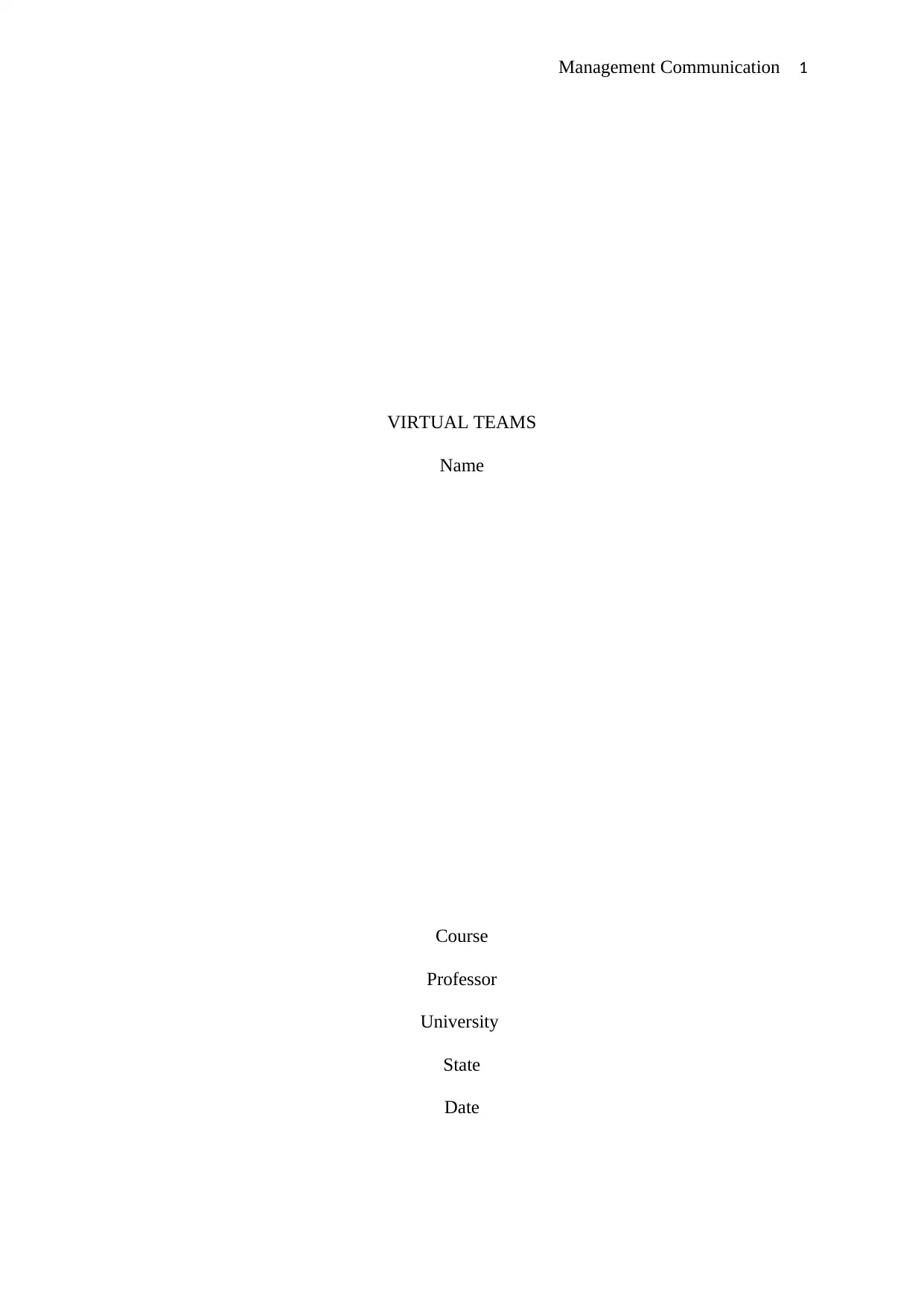
Management Communication 1
VIRTUAL TEAMS
Name
Course
Professor
University
State
Date
VIRTUAL TEAMS
Name
Course
Professor
University
State
Date
Paraphrase This Document
Need a fresh take? Get an instant paraphrase of this document with our AI Paraphraser
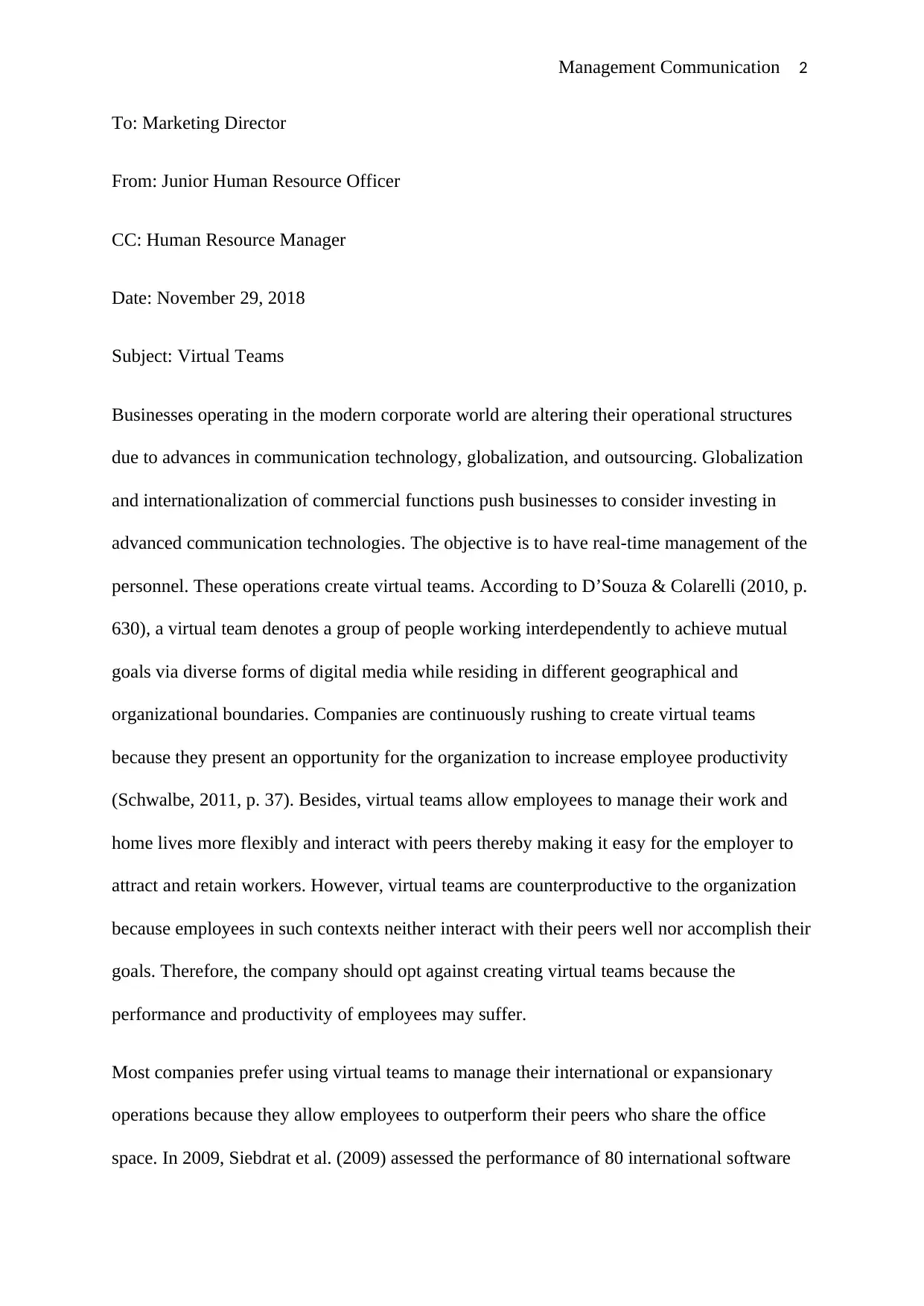
Management Communication 2
To: Marketing Director
From: Junior Human Resource Officer
CC: Human Resource Manager
Date: November 29, 2018
Subject: Virtual Teams
Businesses operating in the modern corporate world are altering their operational structures
due to advances in communication technology, globalization, and outsourcing. Globalization
and internationalization of commercial functions push businesses to consider investing in
advanced communication technologies. The objective is to have real-time management of the
personnel. These operations create virtual teams. According to D’Souza & Colarelli (2010, p.
630), a virtual team denotes a group of people working interdependently to achieve mutual
goals via diverse forms of digital media while residing in different geographical and
organizational boundaries. Companies are continuously rushing to create virtual teams
because they present an opportunity for the organization to increase employee productivity
(Schwalbe, 2011, p. 37). Besides, virtual teams allow employees to manage their work and
home lives more flexibly and interact with peers thereby making it easy for the employer to
attract and retain workers. However, virtual teams are counterproductive to the organization
because employees in such contexts neither interact with their peers well nor accomplish their
goals. Therefore, the company should opt against creating virtual teams because the
performance and productivity of employees may suffer.
Most companies prefer using virtual teams to manage their international or expansionary
operations because they allow employees to outperform their peers who share the office
space. In 2009, Siebdrat et al. (2009) assessed the performance of 80 international software
To: Marketing Director
From: Junior Human Resource Officer
CC: Human Resource Manager
Date: November 29, 2018
Subject: Virtual Teams
Businesses operating in the modern corporate world are altering their operational structures
due to advances in communication technology, globalization, and outsourcing. Globalization
and internationalization of commercial functions push businesses to consider investing in
advanced communication technologies. The objective is to have real-time management of the
personnel. These operations create virtual teams. According to D’Souza & Colarelli (2010, p.
630), a virtual team denotes a group of people working interdependently to achieve mutual
goals via diverse forms of digital media while residing in different geographical and
organizational boundaries. Companies are continuously rushing to create virtual teams
because they present an opportunity for the organization to increase employee productivity
(Schwalbe, 2011, p. 37). Besides, virtual teams allow employees to manage their work and
home lives more flexibly and interact with peers thereby making it easy for the employer to
attract and retain workers. However, virtual teams are counterproductive to the organization
because employees in such contexts neither interact with their peers well nor accomplish their
goals. Therefore, the company should opt against creating virtual teams because the
performance and productivity of employees may suffer.
Most companies prefer using virtual teams to manage their international or expansionary
operations because they allow employees to outperform their peers who share the office
space. In 2009, Siebdrat et al. (2009) assessed the performance of 80 international software
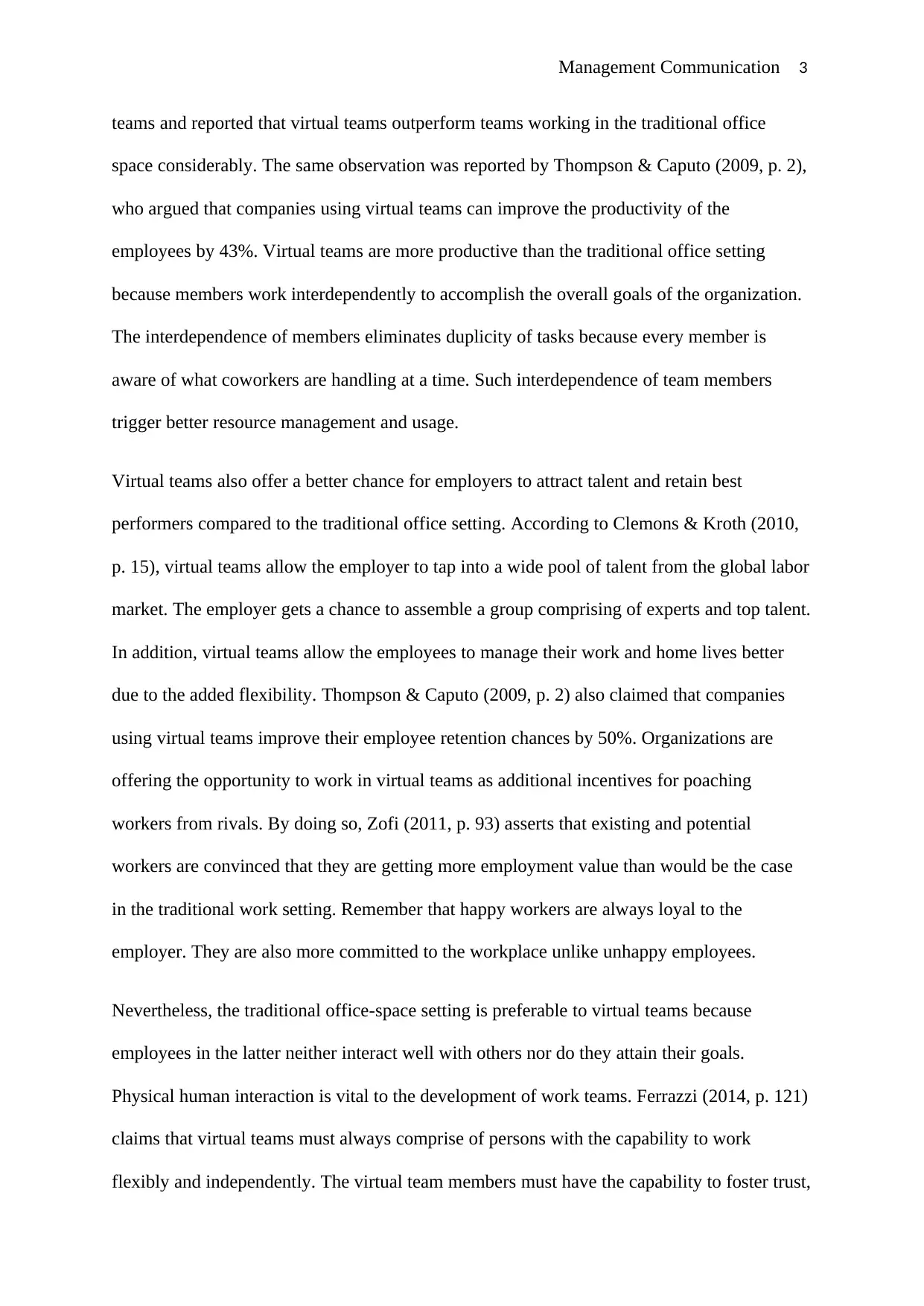
Management Communication 3
teams and reported that virtual teams outperform teams working in the traditional office
space considerably. The same observation was reported by Thompson & Caputo (2009, p. 2),
who argued that companies using virtual teams can improve the productivity of the
employees by 43%. Virtual teams are more productive than the traditional office setting
because members work interdependently to accomplish the overall goals of the organization.
The interdependence of members eliminates duplicity of tasks because every member is
aware of what coworkers are handling at a time. Such interdependence of team members
trigger better resource management and usage.
Virtual teams also offer a better chance for employers to attract talent and retain best
performers compared to the traditional office setting. According to Clemons & Kroth (2010,
p. 15), virtual teams allow the employer to tap into a wide pool of talent from the global labor
market. The employer gets a chance to assemble a group comprising of experts and top talent.
In addition, virtual teams allow the employees to manage their work and home lives better
due to the added flexibility. Thompson & Caputo (2009, p. 2) also claimed that companies
using virtual teams improve their employee retention chances by 50%. Organizations are
offering the opportunity to work in virtual teams as additional incentives for poaching
workers from rivals. By doing so, Zofi (2011, p. 93) asserts that existing and potential
workers are convinced that they are getting more employment value than would be the case
in the traditional work setting. Remember that happy workers are always loyal to the
employer. They are also more committed to the workplace unlike unhappy employees.
Nevertheless, the traditional office-space setting is preferable to virtual teams because
employees in the latter neither interact well with others nor do they attain their goals.
Physical human interaction is vital to the development of work teams. Ferrazzi (2014, p. 121)
claims that virtual teams must always comprise of persons with the capability to work
flexibly and independently. The virtual team members must have the capability to foster trust,
teams and reported that virtual teams outperform teams working in the traditional office
space considerably. The same observation was reported by Thompson & Caputo (2009, p. 2),
who argued that companies using virtual teams can improve the productivity of the
employees by 43%. Virtual teams are more productive than the traditional office setting
because members work interdependently to accomplish the overall goals of the organization.
The interdependence of members eliminates duplicity of tasks because every member is
aware of what coworkers are handling at a time. Such interdependence of team members
trigger better resource management and usage.
Virtual teams also offer a better chance for employers to attract talent and retain best
performers compared to the traditional office setting. According to Clemons & Kroth (2010,
p. 15), virtual teams allow the employer to tap into a wide pool of talent from the global labor
market. The employer gets a chance to assemble a group comprising of experts and top talent.
In addition, virtual teams allow the employees to manage their work and home lives better
due to the added flexibility. Thompson & Caputo (2009, p. 2) also claimed that companies
using virtual teams improve their employee retention chances by 50%. Organizations are
offering the opportunity to work in virtual teams as additional incentives for poaching
workers from rivals. By doing so, Zofi (2011, p. 93) asserts that existing and potential
workers are convinced that they are getting more employment value than would be the case
in the traditional work setting. Remember that happy workers are always loyal to the
employer. They are also more committed to the workplace unlike unhappy employees.
Nevertheless, the traditional office-space setting is preferable to virtual teams because
employees in the latter neither interact well with others nor do they attain their goals.
Physical human interaction is vital to the development of work teams. Ferrazzi (2014, p. 121)
claims that virtual teams must always comprise of persons with the capability to work
flexibly and independently. The virtual team members must have the capability to foster trust,
⊘ This is a preview!⊘
Do you want full access?
Subscribe today to unlock all pages.

Trusted by 1+ million students worldwide
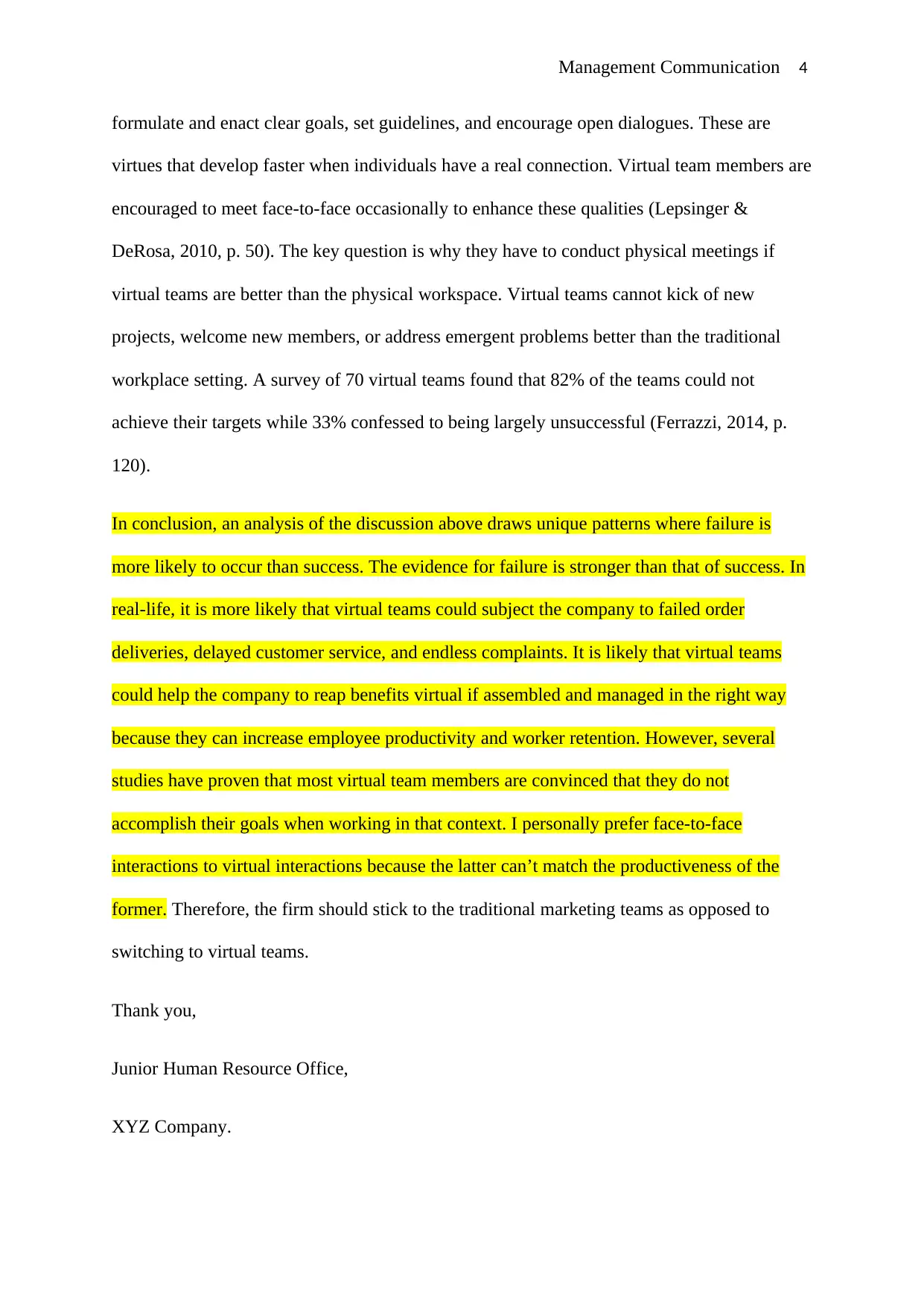
Management Communication 4
formulate and enact clear goals, set guidelines, and encourage open dialogues. These are
virtues that develop faster when individuals have a real connection. Virtual team members are
encouraged to meet face-to-face occasionally to enhance these qualities (Lepsinger &
DeRosa, 2010, p. 50). The key question is why they have to conduct physical meetings if
virtual teams are better than the physical workspace. Virtual teams cannot kick of new
projects, welcome new members, or address emergent problems better than the traditional
workplace setting. A survey of 70 virtual teams found that 82% of the teams could not
achieve their targets while 33% confessed to being largely unsuccessful (Ferrazzi, 2014, p.
120).
In conclusion, an analysis of the discussion above draws unique patterns where failure is
more likely to occur than success. The evidence for failure is stronger than that of success. In
real-life, it is more likely that virtual teams could subject the company to failed order
deliveries, delayed customer service, and endless complaints. It is likely that virtual teams
could help the company to reap benefits virtual if assembled and managed in the right way
because they can increase employee productivity and worker retention. However, several
studies have proven that most virtual team members are convinced that they do not
accomplish their goals when working in that context. I personally prefer face-to-face
interactions to virtual interactions because the latter can’t match the productiveness of the
former. Therefore, the firm should stick to the traditional marketing teams as opposed to
switching to virtual teams.
Thank you,
Junior Human Resource Office,
XYZ Company.
formulate and enact clear goals, set guidelines, and encourage open dialogues. These are
virtues that develop faster when individuals have a real connection. Virtual team members are
encouraged to meet face-to-face occasionally to enhance these qualities (Lepsinger &
DeRosa, 2010, p. 50). The key question is why they have to conduct physical meetings if
virtual teams are better than the physical workspace. Virtual teams cannot kick of new
projects, welcome new members, or address emergent problems better than the traditional
workplace setting. A survey of 70 virtual teams found that 82% of the teams could not
achieve their targets while 33% confessed to being largely unsuccessful (Ferrazzi, 2014, p.
120).
In conclusion, an analysis of the discussion above draws unique patterns where failure is
more likely to occur than success. The evidence for failure is stronger than that of success. In
real-life, it is more likely that virtual teams could subject the company to failed order
deliveries, delayed customer service, and endless complaints. It is likely that virtual teams
could help the company to reap benefits virtual if assembled and managed in the right way
because they can increase employee productivity and worker retention. However, several
studies have proven that most virtual team members are convinced that they do not
accomplish their goals when working in that context. I personally prefer face-to-face
interactions to virtual interactions because the latter can’t match the productiveness of the
former. Therefore, the firm should stick to the traditional marketing teams as opposed to
switching to virtual teams.
Thank you,
Junior Human Resource Office,
XYZ Company.
Paraphrase This Document
Need a fresh take? Get an instant paraphrase of this document with our AI Paraphraser
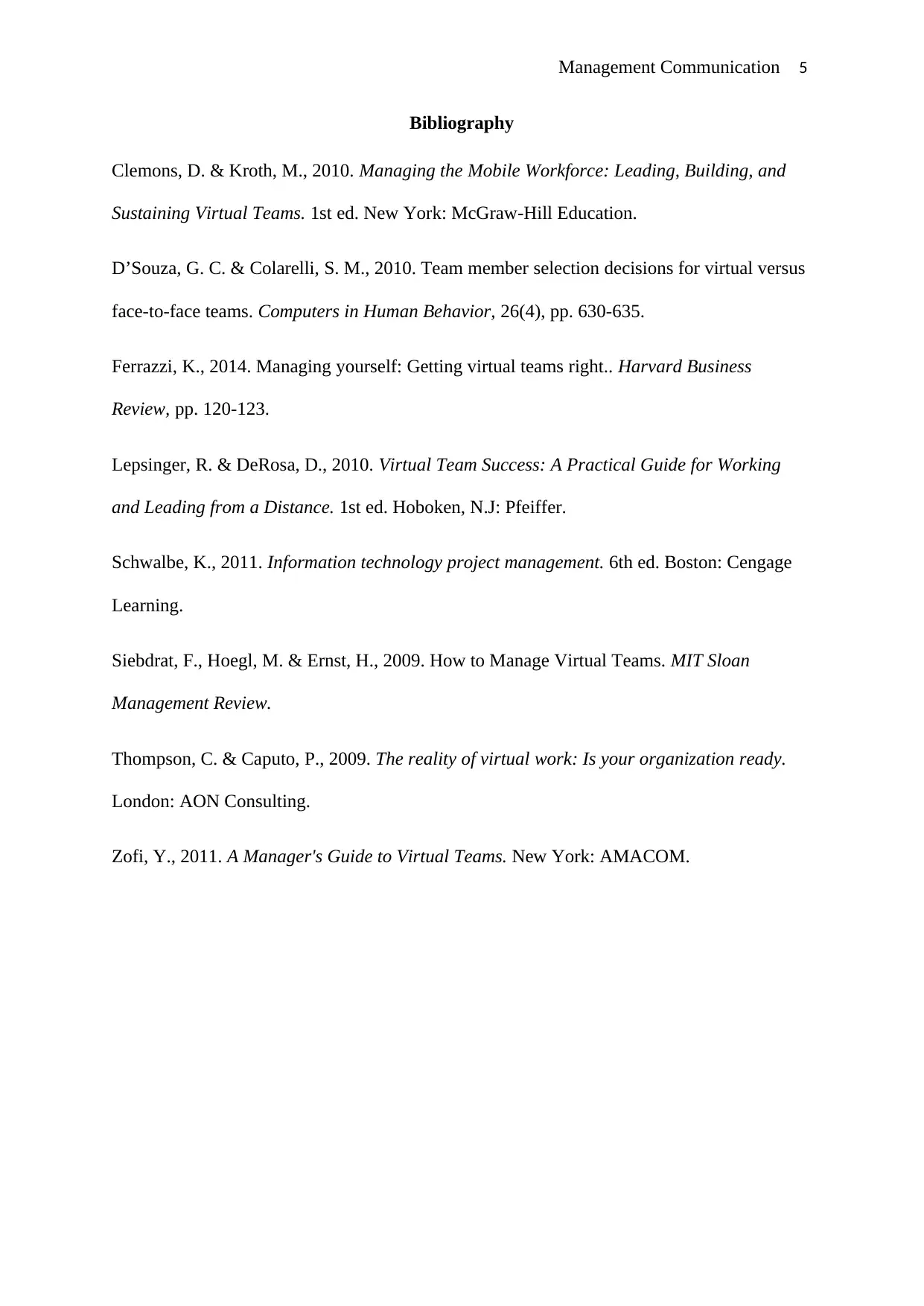
Management Communication 5
Bibliography
Clemons, D. & Kroth, M., 2010. Managing the Mobile Workforce: Leading, Building, and
Sustaining Virtual Teams. 1st ed. New York: McGraw-Hill Education.
D’Souza, G. C. & Colarelli, S. M., 2010. Team member selection decisions for virtual versus
face-to-face teams. Computers in Human Behavior, 26(4), pp. 630-635.
Ferrazzi, K., 2014. Managing yourself: Getting virtual teams right.. Harvard Business
Review, pp. 120-123.
Lepsinger, R. & DeRosa, D., 2010. Virtual Team Success: A Practical Guide for Working
and Leading from a Distance. 1st ed. Hoboken, N.J: Pfeiffer.
Schwalbe, K., 2011. Information technology project management. 6th ed. Boston: Cengage
Learning.
Siebdrat, F., Hoegl, M. & Ernst, H., 2009. How to Manage Virtual Teams. MIT Sloan
Management Review.
Thompson, C. & Caputo, P., 2009. The reality of virtual work: Is your organization ready.
London: AON Consulting.
Zofi, Y., 2011. A Manager's Guide to Virtual Teams. New York: AMACOM.
Bibliography
Clemons, D. & Kroth, M., 2010. Managing the Mobile Workforce: Leading, Building, and
Sustaining Virtual Teams. 1st ed. New York: McGraw-Hill Education.
D’Souza, G. C. & Colarelli, S. M., 2010. Team member selection decisions for virtual versus
face-to-face teams. Computers in Human Behavior, 26(4), pp. 630-635.
Ferrazzi, K., 2014. Managing yourself: Getting virtual teams right.. Harvard Business
Review, pp. 120-123.
Lepsinger, R. & DeRosa, D., 2010. Virtual Team Success: A Practical Guide for Working
and Leading from a Distance. 1st ed. Hoboken, N.J: Pfeiffer.
Schwalbe, K., 2011. Information technology project management. 6th ed. Boston: Cengage
Learning.
Siebdrat, F., Hoegl, M. & Ernst, H., 2009. How to Manage Virtual Teams. MIT Sloan
Management Review.
Thompson, C. & Caputo, P., 2009. The reality of virtual work: Is your organization ready.
London: AON Consulting.
Zofi, Y., 2011. A Manager's Guide to Virtual Teams. New York: AMACOM.
1 out of 5
Related Documents
Your All-in-One AI-Powered Toolkit for Academic Success.
+13062052269
info@desklib.com
Available 24*7 on WhatsApp / Email
![[object Object]](/_next/static/media/star-bottom.7253800d.svg)
Unlock your academic potential
Copyright © 2020–2025 A2Z Services. All Rights Reserved. Developed and managed by ZUCOL.



